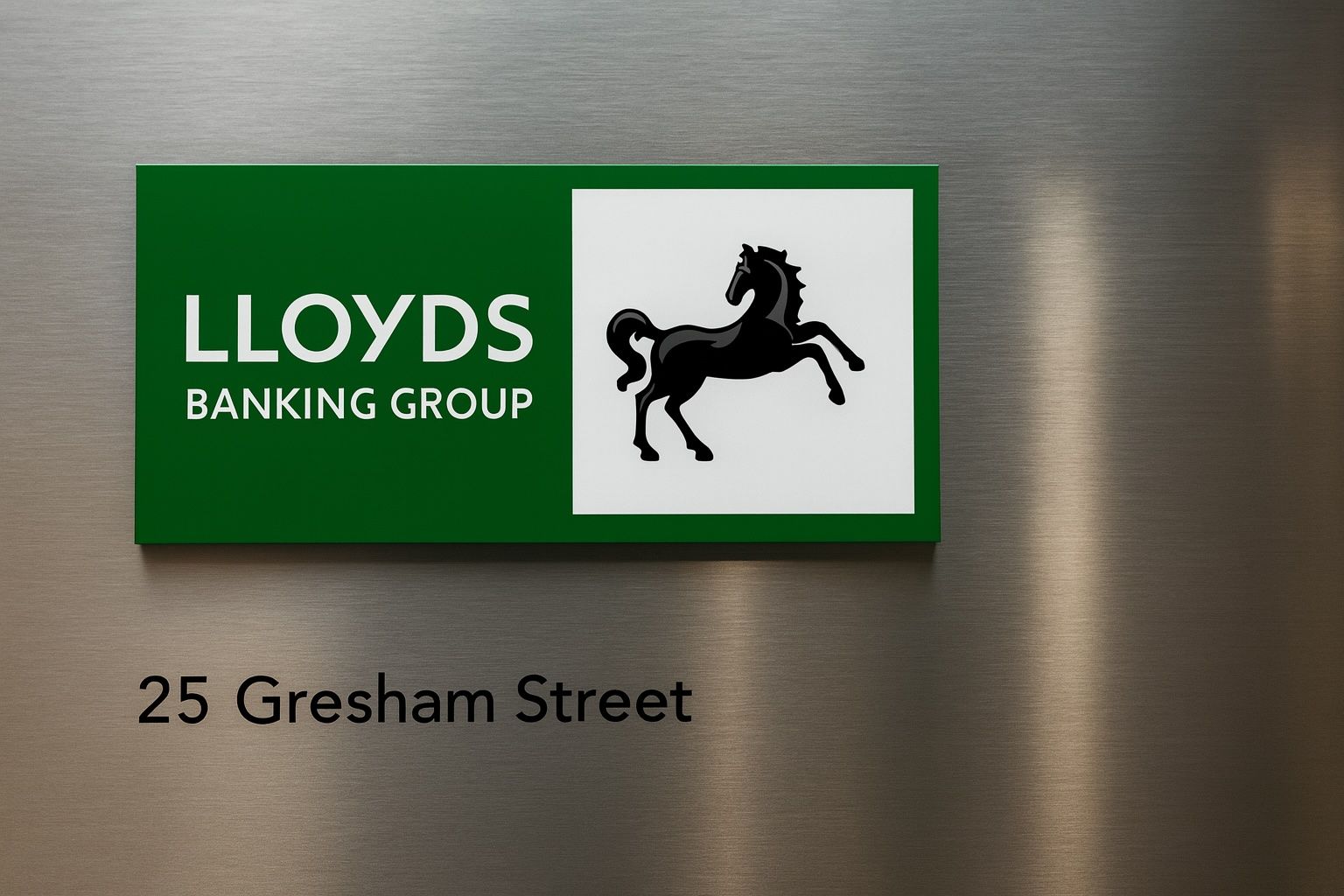- Current Share Price:~86.3 pence as of 27 Oct 2025, hovering near its highest level in 10 years [1] [2]. Lloyds (LLOY.L) stock has surged about 50% in 2025, vastly outperforming the FTSE 100’s ~15% gain [3] [4].
- Q3 Profit Plunge:£1.17 billion pre-tax profit in Q3 (Jul–Sep) – down 36% year-on-year – after an £800 million scandal charge [5] [6]. Underlying earnings beat forecasts, but Lloyds trimmed its full-year return-on-equity target to ~12% (from 13.5%) [7] [8].
- £2bn Mis-Selling Scandal: Total provisions for a motor-finance mis-selling scandal now stand at £1.95 billion [9]. Regulators estimate an ~£11bn industry-wide cost [10]. Analysts expressed “some relief” that Lloyds’ extra £800m charge wasn’t larger [11], but the saga remains one of the costliest UK banking scandals.
- Investor Sentiment: The bank’s dividend (yield ~3.8–4%) is back [12] and a £2bn share buyback is underway [13], boosting shareholder returns. City analysts’ average 12-month price target ~93p [14] (about 10% above current levels), with bullish targets up to ~105p, reflect cautious optimism. At ~86p, Lloyds trades around 12–13× forward earnings, richer than peers [15], suggesting much good news is already priced in.
- Market Context: High UK interest rates have turbocharged banks’ profits, benefiting Lloyds’ lending margins [16]. UK bank stocks are broadly rallying – rival NatWest’s share price is up ~53% in the past year [17] – as the sector rebounds. Yet political uncertainty (talk of a potential bank tax in the upcoming Autumn Budget) and economic risks temper the outlook [18] [19].
Lloyds Stock Near 10-Year High After 50% Surge
Lloyds Banking Group shares have been on a tear this year, climbing to levels not seen since 2015. As of October 27, 2025, LLOY.L trades around 86 pence, up slightly on the day [20] and sitting just below its ~86.6p peak for the month (a decade high reached mid-October) [21]. The stock has rallied ~50% in 2025, making Lloyds one of the FTSE 100’s standout performers [22]. By comparison, the blue-chip FTSE 100 index is up roughly 15% year-to-date and other UK bank stocks have also climbed, buoyed by an improved economic backdrop and earnings recovery [23] [24]. Elevated Bank of England interest rates – currently at multiyear highs – have widened banks’ net interest margins (the gap between lending and deposit rates), a key profit driver for Lloyds [25].
Investors are also encouraged by Lloyds’ reinstated dividends and share buybacks. The bank resumed dividend payments (the stock yields ~4% at current prices) and is partway through a £2bn share repurchase program for 2025 [26] [27]. These shareholder returns signal management’s confidence in capital strength. “Lloyds Banking Group appears to be on solid footing… the share price is near its highest in a decade, supported by strong fundamentals,” noted a TS2.tech market analysis earlier this month [28]. The bank’s Common Equity Tier-1 (CET1) capital ratio is a healthy ~13.8%, well above regulatory minimums, even after accounting for recent charges [29].
Recent Trading: Lloyds’ stock has shown resilience around earnings news. When third-quarter results came out on Oct 23, shares dipped about 0.4% initially (versus a flat FTSE 100) [30], as traders reacted to mixed headlines. However, the selloff was modest and short-lived – by that afternoon the stock had largely recovered its intraday losses, suggesting investors found no major negative surprises in the report [31]. Lloyds ended last week roughly flat around 85.9p, and has inched higher at the start of this week. Year-to-date, the stock’s rally has put it near the top of the FTSE 100 leaderboard – a remarkable turnaround for a bank that lagged in prior years [32] [33].
Q3 2025 Earnings: Strong Core Business vs. One-Off Hit
Lloyds’ third-quarter results, reported on October 23, underscored a solid core performance overshadowed by one hefty charge. The bank delivered £1.17 billion pre-tax profit for Q3 2025, which was 36% lower than the £1.8bn earned in Q3 2024 [34]. This profit plunge was entirely due to a one-time provision of £800 million for a regulatory scandal (more on that below). Excluding that charge, underlying profit actually met or beat analyst forecasts – Reuters noted the £1.17bn result was “broadly in line” with consensus expectations around £1.0bn [35]. The underlying business showed strength: Lloyds increased net interest income by ~6% in the first nine months of 2025, as higher interest rates and a savvy interest-rate hedging strategy boosted yields [36]. The bank also attracted £3.7bn of net new funds into its insurance and wealth management division this year [37], expanding fee-based income streams beyond lending.
Crucially, Lloyds tightened its guidance in light of the scandal costs. It cut its full-year return on tangible equity goal to ~12% (from ~13.5% previously) [38] [39], to account for the £800m hit. Still, CEO Charlie Nunn struck an upbeat tone on the underlying performance. “Strong capital generation was supported by income growth, cost discipline and strong asset quality in the first nine months of 2025, despite the impact of the additional motor finance charge in the third quarter,” Nunn said [40]. He emphasized that aside from the one-off provision, the bank is delivering on its strategy – growing revenue, controlling costs, and maintaining prudent credit standards (helped by a stable UK economy with ~4% unemployment and no housing market crash) [41].
Market reaction to the results was muted. Lloyds shares fell slightly on the news (–0.4%) in early trading on Oct 23 [42], underperforming a small rise in the FTSE 100, as investors digested the mixed signals. However, the fact that the underlying profit was solid and the scandal charge had been telegraphed in advance helped prevent a sharper sell-off. “These quarterly results demonstrate that underlying progress remains strong” even with the provision overhang, observed Richard Hunter, Head of Markets at interactive investor [43]. By the end of the day, Lloyds’ stock had largely bounced back from the initial dip [44]. The quick recovery signaled that the £800m charge – while large – was already anticipated by the market and considered a containable hit.
Aside from earnings, Lloyds made a notable strategic move earlier in October: on Oct 9, the group announced it will buy out Schroders’ 49.9% stake in their UK wealth management joint venture (Schroders Personal Wealth), taking full ownership [45] [46]. This deal (paid in stock) will allow Lloyds to integrate and rebrand the business as “Lloyds Wealth,” aligning with its push into serving “mass affluent” clients. The bank’s aim is to boost fee-based revenue from financial planning and investments – an initiative analysts see as a positive diversification beyond core lending [47]. The wealth push, together with Lloyds’ insurance arm (Scottish Widows) and new digital advisory tools, is part of management’s strategy to drive growth outside traditional banking [48].
£2 Billion Motor-Finance Mis-Selling Scandal
Looming over Lloyds’ otherwise solid results is the motor finance mis-selling scandal – a costly legacy issue that has become a nearly £2 billion problem for the bank. Earlier this month, Britain’s Financial Conduct Authority (FCA) unveiled a proposed redress scheme to compensate customers mis-sold car loans between 2007 and 2024 [49]. The industry-wide price tag is staggering: the FCA estimates lenders may have to pay around £11 billion in total to affected borrowers [50] for years of opaque auto financing deals that broke consumer protection rules. As the UK’s largest motor finance provider (through its Black Horse subsidiary), Lloyds faces the single biggest share of that bill [51].
By mid-October, Lloyds had already set aside £1.15bn for this issue and warned that additional “material” charges were likely [52]. Those fears were confirmed on Oct 13, when Lloyds announced an extra £800 million provision, bringing its total provisions to £1.95 billion [53]. This one-off top-up nearly doubled the bank’s expected liability. It ranks among the costliest misconduct charges in UK banking since the payment protection insurance (PPI) scandal. Lloyds’ Q3 profit plunge and guidance cut were direct consequences of absorbing this hit [54].
The good news, such as it is, was that the final number fell within the range analysts had braced for. In fact, the actual £800m charge was in line with many forecasts (City analysts had penciled in roughly £1.5–1.8bn total provisions for Lloyds) [55]. “There is some relief today that ‘material’ top-up didn’t equate to a much larger number,” remarked Benjamin Toms, an RBC Capital Markets analyst, once Lloyds confirmed the £800m figure [56]. Investors reacted with relief that the uncertainty was lifting – Lloyds’ shares jumped ~1.6% on Oct 13 when the bank quantified the new provision [57]. By taking the hit now, Lloyds aims to put the issue largely behind it and move forward.
That said, the scandal remains a significant overhang. The FCA’s consultation on the redress scheme is ongoing, and Lloyds has signaled it will challenge the regulator’s methodology for calculating compensation [58] [59]. Lloyds argues the proposed formula may overcompensate many customers – potentially covering 14 million+ car loan contracts, including cases the bank feels were not truly mis-sold [60]. CEO Charlie Nunn has publicly warned that the FCA’s plan could “take 20 years of profitability off the car finance industry” and hurt the sector’s ability to lend [61]. Lloyds is lobbying for a fairer approach, even as it prepares to pay out claims. Any drawn-out legal wrangling with the FCA could prolong the uncertainty, but with nearly £2bn set aside, Lloyds has “girded for the worst-case” and does not expect to cut its dividends or growth initiatives because of this issue [62].
Notably, Lloyds’ willingness to absorb the charge upfront has been viewed positively in that it provides clarity. By recognizing the full £1.95bn provision, the bank has taken a very conservative stance – essentially front-loading the pain. This has given investors and analysts more confidence that a line can be drawn under the episode. “The scandal is still an overhang, but at least we now have a number to work with – and it wasn’t as bad as some feared,” commented one market strategist. The focus can then shift back to Lloyds’ ongoing operations, assuming no further surprises emerge from the mis-selling saga.
Analyst Forecasts, Valuation and Risks
Despite this year’s impressive rally – or rather, because of it – experts are split on how much upside is left in Lloyds’ share price. City analysts’ 12-month price targets for LLOY currently average around 93 pence [63], roughly 8–10% above the latest trading levels. That consensus suggests expectations of moderate further gains over the next year. Some brokers are more bullish: for instance, Jefferies recently raised its target to 105p (from 103p) and reiterated a “buy” rating [64], implying around 25% upside potential. Others are more cautious, with a few targets in the mid-80s to low-90s (near where the stock already trades) reflecting little expected upside. RBC Capital is among those taking a tempered view – their analysts see Lloyds in the mid-90s (pence) and note that the bank’s valuation is no longer cheap relative to peers [65].
At current ~86p, Lloyds shares trade at approximately 12–13 times forward earnings (P/E) [66], which is higher than many rival European banks. The stock is also valued around 1.1× book value (share price relative to net assets) [67] [68], a multiple not seen in years, indicating the market is assigning a premium for Lloyds’ return to form. These richer valuations “suggest much of the good news is priced in”, as TS2.tech’s analysis observed [69]. In other words, investors have already baked in expectations of strong profits, dividends and a benign credit environment. Any disappointment in execution or external conditions could cap the stock’s near-term gains.
On the positive side, Lloyds offers a blend of income and growth that appeals to a broad investor base. Even after its rise, the stock yields about 3.8–4% in dividends [70] – attractive in a low-rate environment (should interest rates start falling next year). The bank is expected to continue increasing its payout (2025’s total dividend of ~3.6p per share is forecast to rise in 2026–27) [71], and ongoing share buybacks will boost earnings per share. In fact, one analysis noted that Lloyds’ EPS could grow ~76% by 2027 thanks to buybacks and profit expansion [72]. Thus, for long-term investors, Lloyds still presents a case for value, provided the UK economy stays on track.
However, risks abound that could limit further share price appreciation. Competitive pressures in the mortgage and lending market are rising – as interest rates stabilize, banks may fight harder for customers, squeezing margins. The UK economy, while resilient this year, faces headwinds from high inflation, cost-of-living pressures on consumers, and geopolitical uncertainties. If credit conditions deteriorate (e.g. a spike in loan defaults or a housing downturn), Lloyds’ predominantly UK retail loan book would feel the pain. There’s also political risk: with a general election on the horizon (by 2025’s end or 2026) and public scrutiny on bank profits, there have been rumblings about windfall taxes or higher bank levies in the UK. Speculation about a potential “bank tax” in the upcoming Autumn Budget has already “elevated fears across the City,” according to financial press [73]. Any such move could directly hit bank earnings or reduce investor enthusiasm for the sector.
Technical Trends and Market Context
From a technical chart perspective, Lloyds’ stock is at a crossroads. The mid-80s pence level has roughly marked the ceiling for LLOY in recent years – it’s the highest zone the shares have traded at since before the 2016 Brexit referendum [74]. A decisive break above ~87p (the October peak) on strong volume would constitute a bullish multi-year breakout, potentially clearing the path toward psychological round-numbers like 90p and beyond. Some analysts believe sustained momentum could carry the shares back into pre-2010 levels (above 100p) in a best-case scenario, especially if earnings surprises continue on the upside. On the flip side, failure to push through this resistance region could lead to a short-term pullback. After such a steep year-to-date climb, Lloyds might see bouts of profit-taking, where investors lock in gains. The stock’s 50-day and 200-day moving averages (notably lower, in the 70s pence range earlier this year) indicate an established uptrend, but also leave room for a technical correction without breaking the broader positive trend.
It’s also instructive to view Lloyds’ rally in the context of the wider UK banking sector. The bank’s ~50% surge this year, while impressive, is actually a bit behind NatWest Group’s performance (+53% over the last 12 months) [75] and in line with gains in some smaller UK lenders. This suggests a sector-wide re-rating has been underway – investors have revalued British bank equities higher as the country skirted recession and interest rates plateaued at high levels. Banks were among the laggards in prior years (with subdued share prices due to Brexit uncertainty, ultra-low rates, and pandemic impacts), so 2025 has been a catch-up period. Lloyds, being the UK’s largest retail and commercial bank, is often seen as a bellwether for the domestic economy. Its stock tends to trade in line with confidence in UK economic health. Thus, improving GDP growth forecasts, stabilizing consumer finances, and robust employment have lifted sentiment toward Lloyds and peers.
The FTSE 100 index recently hit its highest levels in over 3 years, aided in part by bank stocks’ strength [76]. Within the index, Lloyds now ranks among the top performers year-to-date. Its market capitalization is back above £50 billion [77], re-cementing Lloyds as one of Britain’s most valuable financial institutions. Still, the FTSE’s heavy weighting in other sectors (oil & gas, mining, etc.) means bank shares can diverge based on sector-specific news. For example, UK banks got a boost in early October when the FCA’s motor-finance redress plan came in at the lower end of fears – Lloyds stock jumped 2.6% on Oct 8 after the regulator’s proposal implied a smaller hit than worst-case scenarios [78] [79]. Such moves show how sector news can move individual bank stocks and even the broader index.
Going forward, macro factors will be key in determining if Lloyds’ rally has more room to run. The Bank of England’s rate decisions are a double-edged sword: higher rates have been a boon to bank profits so far, but if the economy slows too much or if rate cuts arrive in 2026, banks’ margins could start to compress. The UK political landscape is another wild card – any major policy changes after the next election (for instance, stricter regulations or tax changes) could impact Lloyds. Investors will also keep an eye on international factors like global market volatility or shocks, which can spill over to financial stocks.
Outlook: Cautious Optimism Ahead
After an extraordinary run in 2025, Lloyds Banking Group’s share price is entering the end of the year with substantial momentum – and a fair share of expectations to live up to. In many ways, the bank now offers a combination of stability and upside: it has strong capital reserves, rising profits (excluding one-offs), and resumed payouts, making it attractive for both income-focused and growth investors. The successful navigation of the post-pandemic recovery and interest rate boom has positioned Lloyds to generate healthy returns (12%+ ROE) even after accounting for legacy issues [80]. As a result, the stock currently provides both capital growth and dividend income opportunities for shareholders [81].
However, most analysts urge a degree of caution. The near-50% rally this year means the easy gains have been made – the stock’s valuation already reflects robust earnings and then some [82]. “The rally has priced in much of the good news,” one commentator noted [83], suggesting that upside from here will likely be incremental unless Lloyds delivers positive surprises. Looking ahead, several factors will determine the share’s trajectory: UK economic signals (inflation trends, consumer spending, housing market health), the final outcome of the motor-loan scandal resolution, and any policy moves affecting banks (such as the rumored tax proposals) [84]. These will be closely watched in the coming months.
The consensus among City experts is for moderate growth in Lloyds’ stock over the next year, rather than a continued meteoric rise. In practical terms, that means the share price could grind higher into the 90s pence, but likely with more volatility and sensitivity to news. Short-term catalysts include the Bank of England’s next actions (a rate cut in 2026, if signaled, might initially spook bank investors but could also boost economic activity) and Lloyds’ own forthcoming earnings reports (investors will want to see loan books holding up and costs under control). Conversely, any shock – be it a surprise jump in bad loans or an unfavorable regulatory decision – could trigger a correction from these lofty levels.
Overall, the outlook for Lloyds is one of guarded optimism. The bank has emerged from a challenging decade (marked by low rates and past scandals) into a period of improved profitability and market confidence. It has momentum on its side, but also a higher bar to clear. For now, Lloyds’ shareholders can take comfort in the bank’s return to health – a decade-high share price, rising payouts, and a leadership willing to tackle problems head-on. The coming quarters will reveal whether this iconic FTSE 100 lender can build on 2025’s success or if it will hit a ceiling. In the words of one financial analyst, “Lloyds has given investors a lot to cheer this year. The next test is showing that this performance is sustainable – that the bank can keep growing steadily even as one-off boosts fade.” With a solid foundation and eyes on potential hurdles, Lloyds enters late 2025 in a stronger position than it has in years, but with the market’s expectations likewise at a decade-high. The balance of risks vs. rewards will decide if the stock’s bull run continues into 2026 or takes a breather in the face of new challenges.
Sources: Reuters, The Guardian, CityAM, TS2.tech analysis, Interactive Investor commentary [85] [86] [87] [88], and other financial news reports. All data and events as of October 27, 2025.
References
1. ts2.tech, 2. www.reuters.com, 3. ts2.tech, 4. ts2.tech, 5. ts2.tech, 6. www.reuters.com, 7. ts2.tech, 8. www.reuters.com, 9. ts2.tech, 10. ts2.tech, 11. ts2.tech, 12. ts2.tech, 13. ts2.tech, 14. ts2.tech, 15. ts2.tech, 16. ts2.tech, 17. ts2.tech, 18. ts2.tech, 19. ts2.tech, 20. www.reuters.com, 21. ts2.tech, 22. ts2.tech, 23. ts2.tech, 24. ts2.tech, 25. ts2.tech, 26. ts2.tech, 27. ts2.tech, 28. ts2.tech, 29. ts2.tech, 30. ts2.tech, 31. ts2.tech, 32. ts2.tech, 33. ts2.tech, 34. ts2.tech, 35. ts2.tech, 36. ts2.tech, 37. ts2.tech, 38. ts2.tech, 39. www.reuters.com, 40. www.reuters.com, 41. ts2.tech, 42. ts2.tech, 43. ts2.tech, 44. ts2.tech, 45. www.reuters.com, 46. www.reuters.com, 47. ts2.tech, 48. ts2.tech, 49. ts2.tech, 50. ts2.tech, 51. ts2.tech, 52. ts2.tech, 53. ts2.tech, 54. ts2.tech, 55. ts2.tech, 56. ts2.tech, 57. ts2.tech, 58. ts2.tech, 59. ts2.tech, 60. ts2.tech, 61. ts2.tech, 62. ts2.tech, 63. ts2.tech, 64. www.sharesmagazine.co.uk, 65. ts2.tech, 66. ts2.tech, 67. www.reuters.com, 68. www.reuters.com, 69. ts2.tech, 70. ts2.tech, 71. ts2.tech, 72. ts2.tech, 73. ts2.tech, 74. ts2.tech, 75. ts2.tech, 76. www.reuters.com, 77. www.reuters.com, 78. www.reuters.com, 79. www.reuters.com, 80. www.reuters.com, 81. ts2.tech, 82. ts2.tech, 83. ts2.tech, 84. ts2.tech, 85. www.reuters.com, 86. ts2.tech, 87. ts2.tech, 88. ts2.tech








